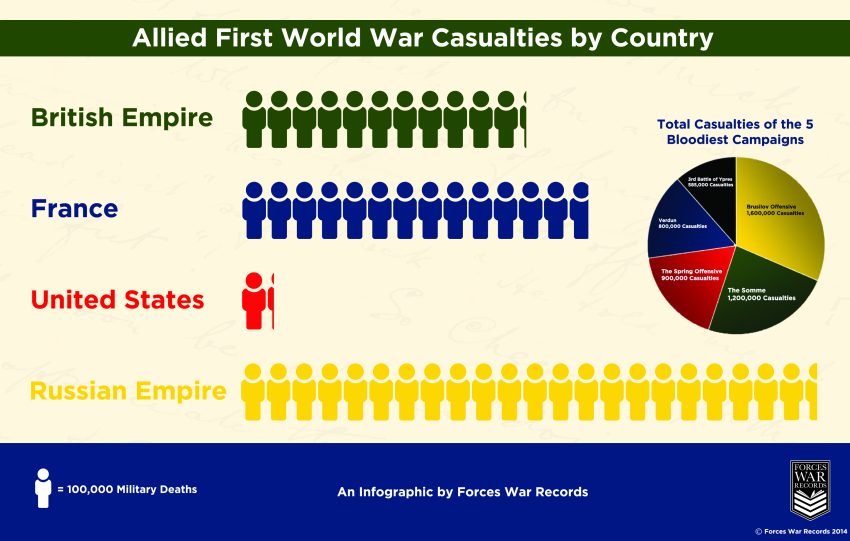Ever wondered which of the Allies suffered most in the First World War, and which battles were the most deadly? Take a look at our infographic of Allied casualties… it’s all right there. At 2.5 million casualties, Russia wins the count by a mile. Looking at the pie chart of the bloodiest campaigns, you begin to see why. The Brusilov Offensive, a campaign undertaken by the Russian army at the urging of the rest of the Allies – with the intention of tying up German divisions so they couldn’t be sent to reinforce the Western Front – again has most casualties. Four hundred thousand more than at the Somme, in fact.
The Russians first committed themselves to action on the Eastern Front at the inter-allied conference at Chantilly, France, in early December 1915. Britain, France, Italy, Serbia and Russia all attended and agreed to work together, and Russia especially claimed it was willing and able to support the allied cause and made a case for co-operations in major offensives. It was a promise that the country, and its leaders, would live to regret.
When the fighting at Verdun kicked off in late February 1916, Russia dutifully sent reinforcements to the Western Front, and launched an attack at Lake Naroch to take the pressure off France and Britain and draw the German forces away from western Europe. Although the Russian Second Army had twice as many guns as the German 10th army, not to mention almost ten times as many troops, they overestimated the effectiveness of their own artillery barrage and underestimated the strength of the German defences. Attacking heavily fortified trenches, bunched into tight formations that made for excellent targets, the Russians somehow lost a fight they shouldn’t have been able to lose, sustaining six times as many casualties as the Germans.
After this unsuccessful encounter the depletion of the Russian Amy was compounded by the Brusilov Offensive, which, as Richard Holmes explains in his ‘The First World War in Photographs’, was named after General Alexei Alexeivich Brusilov, who led the Seventh, Eighth, Ninth and Eleventh Armies into battle at the request of Italy, which had run into difficulties while attacking the Austro-Hungarian border at Isonzo. Russia fulfilled its pledge of support by attacking near the towns of Lviv, Kovel and Lutsk. The first offensive, which involved a short, sharp artillery barrage followed by a speedy attack across a massive 300-mile front, successfully broke through the Austro-Hungarian line. It also achieved its aim of keeping the Germans occupied in the east, so they couldn’t reinforce those fighting in the trenches of Verdun. However, conditions were dreadful, leading to a lot of illness, and the Austrians and Germans fought back with a vengeance. Although Russia technically emerged as the victor by 20th September, the country’s losses were so severe as to permanently cripple the army’s efficiency and the people’s morale.
This, as ‘The First World War: a Miscellany’ by Norman Ferguson explains, was the crux of the civil unrest that was to follow in 1917 (that, and the people’s hatred for Grigori Rasputin, Tsarina Alexandra’s favourite, who increasingly influenced Russian politics with Tsar Nicholas away helping to lead the fighting on the Eastern Front). The Brusilov Offensive set off a chain reaction that was to lead to the Tsar’s downfall, then, after one more failed offensive, to the exhausted country’s truce with Germany and her allies. On 3rd March, 1918, the new Bolshevik government in Russia signed the Treaty of Brest-Litovsk, pledging peace, and broke its treaty with the Allied powers.


